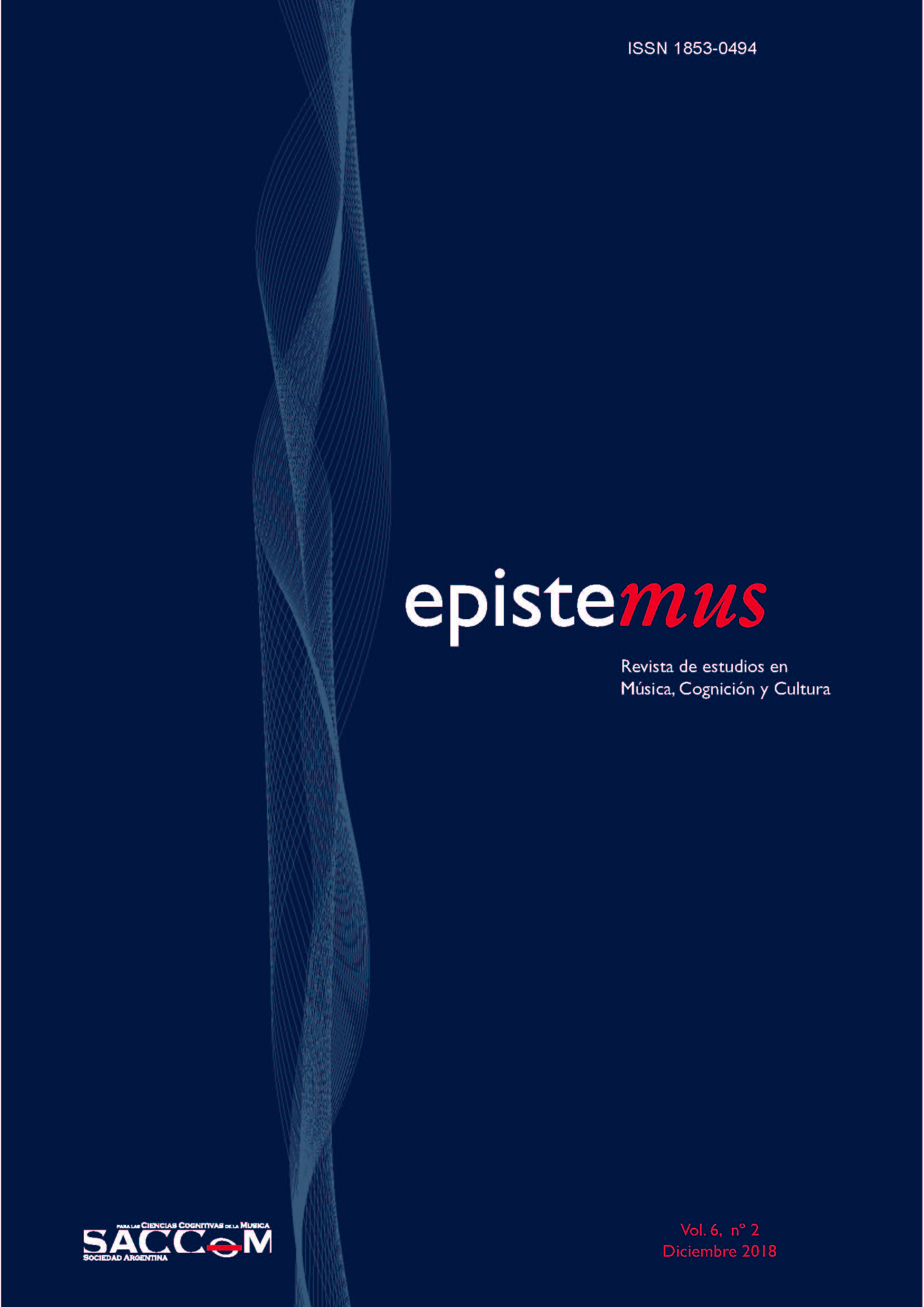Teaching of contemporary music through new technologies
An education experience in university classroom
DOI:
https://doi.org/10.24215/18530494e018Keywords:
on-line education, analysis, contemporary music, teaching, innovative strategiesAbstract
Reception of contemporary music continues to be, at present, for several decades, a thorny issue, worldwide, given the disagreement of this type of music with the public. You can see a similar situation at the educational level, in which the music of the twentieth and twenty-first, generally, shies away from teaching and learning. The present study intends to transmit a didactic experience in higher level students, in which the teaching-learning process of contemporary music has been treated with innovative techniques, from a distance educational model, 100% on line. With a sample of students with no previous experience in the subject, enrolled in the optional subject of Analysis of music of the XX and XXI centuries, it has been tried to elucidate the degree of interest of the students, as well as the degree of knowledge obtained in function of the results, in which four very specific learning factors have affected. The use of digital resources, through the virtual campus, as well as the practice of graphic-sound music analysis, has resulted in successful final performances.
Downloads
Metrics
References
Adorno, T. W. (2000). Sobre la música. Barcelona: Paidós.
Adorno, T. W. (1990). Berg. Alianza, Madrid: Alianza.
Ansermet, E. (2000). Escritos sobre música. Barcelona: Idea Música.
Buch, E. (2010). El caso Schönberg. Buenos Aires: Fondo de Cultura Económica.
Corredor, J. (1985). Casals. Barcelona: Salvat.
Dibelius, U. (2005). La música contemporánea a partir de 1945. Madrid: Akal.
Furtwängler, W. (2011). Conversaciones sobre música. Barcelona: Acantilado.
Griffiths, P. (2010). Modern music and after. Oxford: Oxford University Press.
Harnoncourt, N. (2016). Diálogos sobre Mozart. Barcelona: Acantilado.
Harnoncourt, N. (2006). La música como discurso sonoro. Barcelona: Acantilado.
Lagrange, H. L. (2002). Viena, una historia musical. Barcelona: Paidós.
Madigan, M. (2008). Un acto de libertad. Charlando con Antoni Ros-Marbà. Madrid: Ediciones Autor.
Mantel, G. (2010). Interpretación. Del texto al sonido. Madrid: Alianza.
Marín, M. A. (2018). El ‘big data’ prueba el conservadurismo en la música clásica en vivo. Extraído el 30 de julio de 2018 desde https://elpais.com/cultura/2018/07/22/actualidad/1532252915_160718.html
Menhuin, Y. (2005). Lecciones de vida. Barcelona: Gedisa.
Rosen, C. (2017). Las fronteras del significado. Barcelona: Acantilado.
Rosen, C. (2014). El piano: notas y vivencias. Madrid: Alianza.
Ross, A. (2010). El ruido eterno. Barcelona: Seix Barral.
Schoenberg, A. (1988). Cartas. Madrid: Turner.
Swarowsky, H. (1989). Defensa de la obra. Madrid: Real Musical.
Toch, E. (2001). Elementos constitutivos de la música. Barcelona: Idea Books.
Autor, M. (2018). El análisis gráfico-sonoro como fuente de conocimiento de la obra musical en estudiantes de la Universidad Internacional de La Rioja. REDU - Revista de Docencia Universitaria.
Autor, M. (2018). “Metodología de análisis gráfico-sonoro: estudio paramétrico de la obra en alumnos del Grado de Música de UNIR”. Revista Neuma, Año 10, Vol. 2, Universidad de Talca.
Autor, M. (2016). “Análisis gráfico-sonoro en la enseñanza de la interpretación musical”. UNIR Revista. https://www.unir.net/humanidades/revista/noticias/analisis-grafico-sonoro-en-la-ensenanza-de-la-interpretacion-musical/549201507961/
Webern, A. (2009). El camino de la nueva música. Barcelona: Nortesur.
Walter, B. (2002). Gustav Mahler. Madrid: Alianza.
Xenakis, I. (1955).“La crise de la musique sérielle”. Gravesaner Blätter n ° 1, pp. 2-4.
Downloads
Published
How to Cite
Issue
Section
License
Politica vigente desde octubre de 2019
La aceptación del manuscrito por parte de la revista implica la cesión no exclusiva de los derechos patrimoniales de los/as autores/as en favor del editor, quien permite la reutilización, luego de su edición (postprint), bajo una Licencia Creative Commons Atribución-NoComercial-CompartirIgual 4.0 Internacional (CC BY-NC-SA 4.0)
Acorde a estos términos, el material se puede copiar y redistribuir en cualquier medio o formato siempre que a) se cite la autoría y la fuente original de su publicación (revista y URL de la obra), se brinde el acceso a la licencia y se indique si se realizaron cambios; b) no se utilice el material para fines comerciales.
La cesión de derechos no exclusivos implica que luego de su edición (postprint) en Epistemus los/as autores/as pueden publicar su trabajo en cualquier idioma, medio y formato; en tales casos, se solicita que se consigne que el material fue publicado originalmente en esta revista.
Tal cesión supone, también, la autorización de los/as autores/as para que el trabajo sea cosechado por SEDICI, el repositorio institucional de la Universidad Nacional de La Plata, y sea difundido en las bases de datos que el equipo editorial considere adecuadas para incrementar la visibilidad de la publicación y de sus autores/as.
Asimismo, la revista incentiva a los/as autores/as para que luego de su publicación en Epistemus depositen sus producciones en otros repositorios institucionales y temáticos, bajo el principio de que ofrecer a la sociedad la producción científica y académica sin restricciones contribuye a un mayor intercambio del conocimiento global.

















